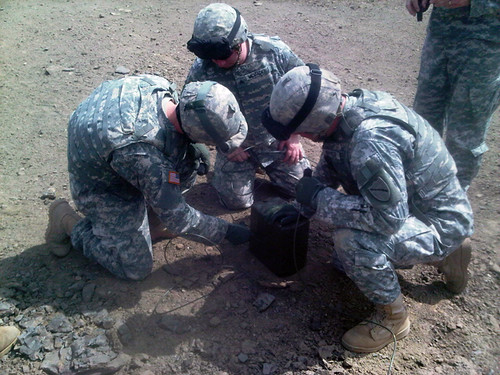Story by Spc. Marty W. Herndon, Unit Public Affairs, Historian Representative, Det 1-1123rd Sapper Co.
NOTE: Each week kentuckyguard.com publishes stories by or about Kentucky National Guard unit public affairs historian representatives, also known as UPAHRs. This is an additional duty taken on by a Soldier or Airmen with the intent of telling their unit’s story. This is one such story ….
[caption id="" align="alignright" width="350"]

Spc. Matthew Winder(left), Sgt. Jonathan T. McMackin(center), and Sgt. 1st Class Edwin J. Bayer (right) of the 206th Engineer Battalion prime a C4 charge while supporting the validation of the new Light Demolition Range located at Wendell H. Ford Regional Training Center. The exercise was the first of its kind at the site. (Kentucky National Guard photo by Master Sgt. Micheal Sims, 206th Engineer Battalion/Released)
GREENVILLE, Ky. -- Soldiers from the 206
th Engineer Battalion and 1123
rd Sapper Company conducted the first test fires of demolitions at Wendell H. Ford Regional Training Center in Greenville, April 3-5, 2012. The test included 1-10 lb charge, 1-25 lb charge and 2-32 ½ lb charges.
“This will allow engineers to conduct demo training for the first time at the Wendell H. Ford Regional Training Center and for some of these Soldiers it was their first time to initiate a charge," said Master Sgt. Micheal E. Sims, Operations Sergeant for the 206
th Engineer Battalion.
The test was conducted to determine the blast shock wave. The decibel level was measured by civilian agencies to determine the capacity of charge to stay within state requirements. The tests were a part of the necessary steps to validate the range for future explosive use. Once the range officially passes these tests, it will receive the green light for further demolition training.
"The demo test went well," said Lt. Col. Ruth Graves, Training Site Manager. "The initial test data results show that blast activities at the demolition range comply with all safety and noise regulations."
Sgt. 1st Class Edwin Bayer, Readiness NCO for Headquarters, Headquarters Company, 206th said nine Soldiers participated in the test, but knows more will follow with this new opportunity.
"It's going to be a great benefit to be able to go down there for training," Bayer said. "It will benefit the entire engineer community in the state."
[caption id="" align="alignleft" width="350"]

A C4 blast ignited by the 206th Engineer Battalion sends debris into the air at the new Light Demolition Range located at Wendell H. Ford Regional Training Center. The 206th assisted with the validation of the site to be used for future demolition training. (Kentucky National Guard photo by Lt. Col. Ruth Graves, Wendell H. Ford Regional Training Center/Released)
When asked about the quality of the training, Bayer said that each Soldier feels the same, 'every opportunity to detonate explosives, is a good day for an engineer'.
The range is expected to host a good amount of training for Kentucky engineers, and the location is one of the greatest advantages. Bayer said previous training had to be scheduled and conducted at Fort Knox or Fort Campbell, but now the Kentucky Guard has its own demolition range.
Following the initial tests, the 201st Engineers were the first to use the range during an annual training period in May. The 1123rd is scheduled to use the range in the fall for demolition certification.
"Our biggest chunk of training is there and we will certainly get a great deal of use out of it," said Bayer.